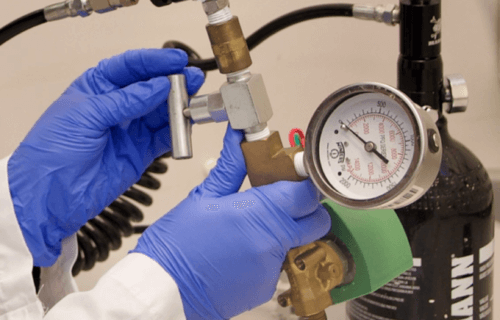INDIANAPOLIS — Good news for people who hate needles — future vaccines could deliver life-threatening drugs with a gentle puff of air to the arm. Scientists say the medicine pushes through the skin, with just a little pressure. It feels like being “hit with a Nerf bullet” — making it much less painful than a jab.
A team from the University of Texas at Dallas says that this system uses powdered vaccines which don’t need refrigeration or a system featuring compressed gas. Their “MOF-Jet” can easily deliver therapeutics against cancer and other diseases in a relatively painless way.
Principal investigator Professor Jeremiah Gassensmith notes their project came about through pandemic-induced boredom. Prof. Gassensmith ordered cheap pieces of a compressed gas-powered jet injection system to play with while sitting at home. Later on, after returning to the campus, Gassensmith handed the pieces over to Yalini Wijesundara, a graduate student in the lab, with one simple request — “see what you can do with this.”
Wijesundara previously studied other jet injectors dating back to the 1960s that use compressed gas to inject a narrow stream of fluid. The PhD student figured out that if researchers could modify the injectors to fire solids, the team could deliver “cargo” sitting inside metal-organic frameworks — or MOFs.
These frameworks are porous, crystalline structures that act like molecular “cages.” They can hold a wide variety of materials, including nucleic acids and proteins. By combining the jet injector with the lab’s existing work on MOFs, Wijesundara created a “MOF-Jet.”

Perfecting the ‘gene gun’
The jet delivers powders to a patient’s cells by, literally, shooting them through the skin with air. The military previously used jet injectors, but they were painful and the fluid often splashed back. This problem could potentially spread other diseases such as Hepatitis B.
A modern-day descendant is the “gene gun” — used in veterinary medicine — can cost tens of thousands of dollars. Those devices also fire biological cargo into the cells. In the new study, the cargo sits on the surface of a metal microparticle, typically consisting of either gold or tungsten.
Once it penetrates the skin, however, the metal particles remain there and can speed up the breakdown of the biological material. Researchers say a different strategy would be to put the medicine inside a MOF.
Prof. Gassensmith’s group previously worked with a MOF called zeolitic-imidazolate framework eight, or ZIF-8.
“Compared to gold, it’s cheap and protects biological materials, such as nucleic acids,” explains Wijesundara explains in a media release. “We can also store vaccine formulations within it as powders at room temperature, which eliminates the need for the extremely cold temperatures many liquid vaccines require.”
The system could revolutionize cancer treatment
The team encased a variety of biological materials within ZIF-8. The material kept them from breaking down too quickly. To deliver the materials into cells, researchers then used their own modified, gene gun-inspired “MOF-Jet.” Wijesundara created “bullets” for the device, each containing a dose of functionalized ZIF-8. A puff of gas fired the powdered formulation into cells, which the study author adds was as easy as “pointing and shooting.”
They tested their system and showed that the MOF-Jet delivered a ZIF-8-encased gene to onion cells and a ZIF-8-encased protein to mice. Prof. Gassensmith says the “blast” from the injector feels “like you got hit with a Nerf bullet.”
By tinkering with the MOF-Jet, Wijesundara realized that they could adjust the release of the medication simply by changing the injector’s carrier gas.
“If you shoot it with carbon dioxide, it will release its cargo faster within cells; if you use regular air, it will take four or five days,” says Gassensmith. This means that the same drug could be released over different timescales without changing its formulation.
“Once we realized that, it opened up a lot of possibilities.”
The team is now using that method to deliver chemotherapeutics as a potential treatment for melanoma, the most serious form of skin cancer. They add that because the MOF-Jet can disperse drugs over a wide area, it could distribute a cancer therapeutic into a cancerous tumor more evenly than a needle, which is the current delivery method.
The team presented their findings at the spring meeting of the American Chemical Society.
South West News Service writer Stephen Beech contributed to this report.

